Switching from Fossil Fuels to Renewable Energy Sources Research 2022
VerifiedAdded on 2022/08/26
|9
|3005
|10
AI Summary
Contribute Materials
Your contribution can guide someone’s learning journey. Share your
documents today.

Switching from Fossil Fuels to Renewable Energy Sources
Secure Best Marks with AI Grader
Need help grading? Try our AI Grader for instant feedback on your assignments.

Contents
1. Background....................................................................................................................................3
2. Aims and objectives.......................................................................................................................5
3. Programme and methodology.......................................................................................................5
4. National Importance......................................................................................................................6
5. Pathways to Impact.......................................................................................................................8
6. Justification of resources (costs do not need to be included)........................................................9
7. References...................................................................................................................................10
1. Background....................................................................................................................................3
2. Aims and objectives.......................................................................................................................5
3. Programme and methodology.......................................................................................................5
4. National Importance......................................................................................................................6
5. Pathways to Impact.......................................................................................................................8
6. Justification of resources (costs do not need to be included)........................................................9
7. References...................................................................................................................................10
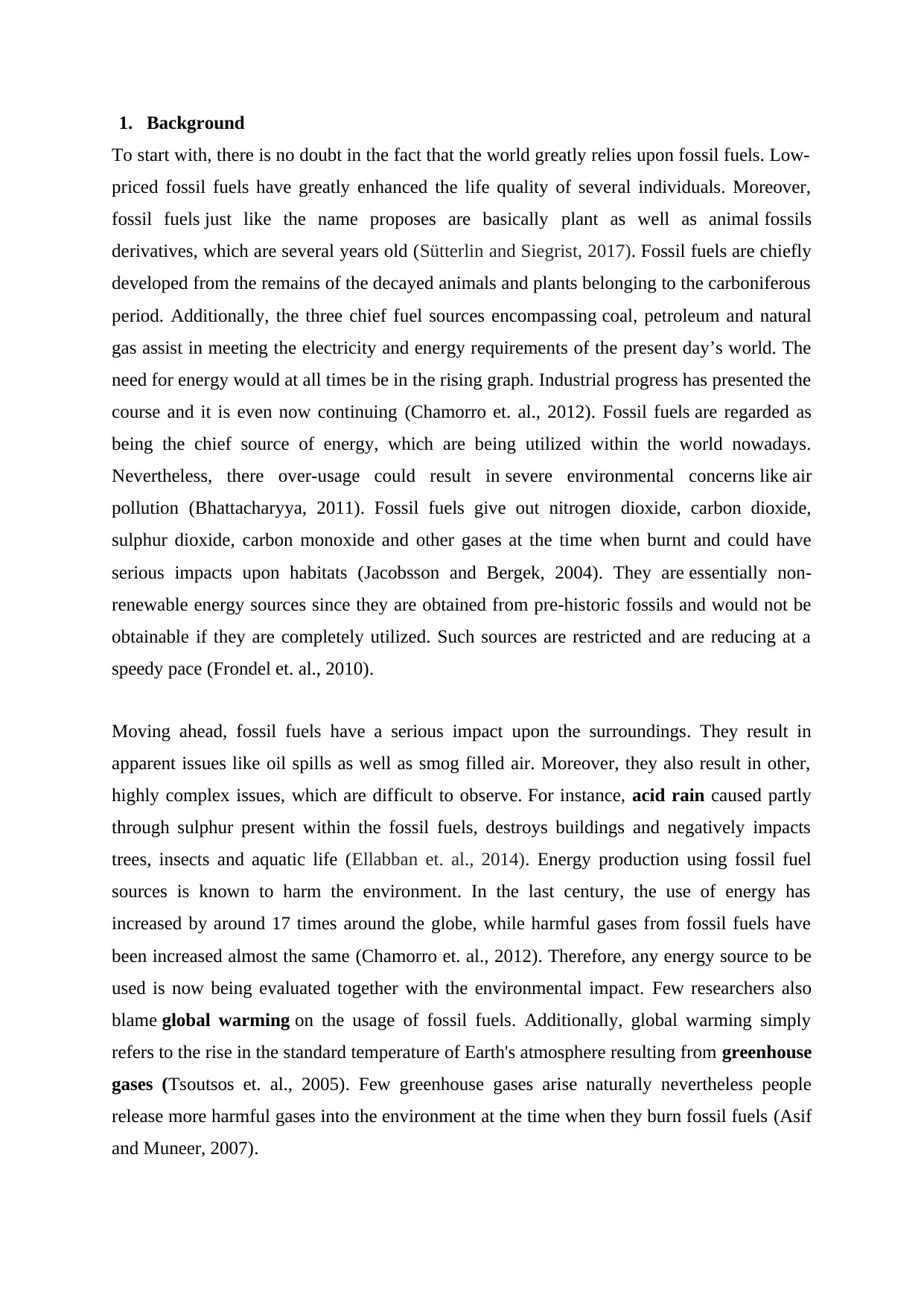
1. Background
To start with, there is no doubt in the fact that the world greatly relies upon fossil fuels. Low-
priced fossil fuels have greatly enhanced the life quality of several individuals. Moreover,
fossil fuels just like the name proposes are basically plant as well as animal fossils
derivatives, which are several years old (Sütterlin and Siegrist, 2017). Fossil fuels are chiefly
developed from the remains of the decayed animals and plants belonging to the carboniferous
period. Additionally, the three chief fuel sources encompassing coal, petroleum and natural
gas assist in meeting the electricity and energy requirements of the present day’s world. The
need for energy would at all times be in the rising graph. Industrial progress has presented the
course and it is even now continuing (Chamorro et. al., 2012). Fossil fuels are regarded as
being the chief source of energy, which are being utilized within the world nowadays.
Nevertheless, there over-usage could result in severe environmental concerns like air
pollution (Bhattacharyya, 2011). Fossil fuels give out nitrogen dioxide, carbon dioxide,
sulphur dioxide, carbon monoxide and other gases at the time when burnt and could have
serious impacts upon habitats (Jacobsson and Bergek, 2004). They are essentially non-
renewable energy sources since they are obtained from pre-historic fossils and would not be
obtainable if they are completely utilized. Such sources are restricted and are reducing at a
speedy pace (Frondel et. al., 2010).
Moving ahead, fossil fuels have a serious impact upon the surroundings. They result in
apparent issues like oil spills as well as smog filled air. Moreover, they also result in other,
highly complex issues, which are difficult to observe. For instance, acid rain caused partly
through sulphur present within the fossil fuels, destroys buildings and negatively impacts
trees, insects and aquatic life (Ellabban et. al., 2014). Energy production using fossil fuel
sources is known to harm the environment. In the last century, the use of energy has
increased by around 17 times around the globe, while harmful gases from fossil fuels have
been increased almost the same (Chamorro et. al., 2012). Therefore, any energy source to be
used is now being evaluated together with the environmental impact. Few researchers also
blame global warming on the usage of fossil fuels. Additionally, global warming simply
refers to the rise in the standard temperature of Earth's atmosphere resulting from greenhouse
gases (Tsoutsos et. al., 2005). Few greenhouse gases arise naturally nevertheless people
release more harmful gases into the environment at the time when they burn fossil fuels (Asif
and Muneer, 2007).
To start with, there is no doubt in the fact that the world greatly relies upon fossil fuels. Low-
priced fossil fuels have greatly enhanced the life quality of several individuals. Moreover,
fossil fuels just like the name proposes are basically plant as well as animal fossils
derivatives, which are several years old (Sütterlin and Siegrist, 2017). Fossil fuels are chiefly
developed from the remains of the decayed animals and plants belonging to the carboniferous
period. Additionally, the three chief fuel sources encompassing coal, petroleum and natural
gas assist in meeting the electricity and energy requirements of the present day’s world. The
need for energy would at all times be in the rising graph. Industrial progress has presented the
course and it is even now continuing (Chamorro et. al., 2012). Fossil fuels are regarded as
being the chief source of energy, which are being utilized within the world nowadays.
Nevertheless, there over-usage could result in severe environmental concerns like air
pollution (Bhattacharyya, 2011). Fossil fuels give out nitrogen dioxide, carbon dioxide,
sulphur dioxide, carbon monoxide and other gases at the time when burnt and could have
serious impacts upon habitats (Jacobsson and Bergek, 2004). They are essentially non-
renewable energy sources since they are obtained from pre-historic fossils and would not be
obtainable if they are completely utilized. Such sources are restricted and are reducing at a
speedy pace (Frondel et. al., 2010).
Moving ahead, fossil fuels have a serious impact upon the surroundings. They result in
apparent issues like oil spills as well as smog filled air. Moreover, they also result in other,
highly complex issues, which are difficult to observe. For instance, acid rain caused partly
through sulphur present within the fossil fuels, destroys buildings and negatively impacts
trees, insects and aquatic life (Ellabban et. al., 2014). Energy production using fossil fuel
sources is known to harm the environment. In the last century, the use of energy has
increased by around 17 times around the globe, while harmful gases from fossil fuels have
been increased almost the same (Chamorro et. al., 2012). Therefore, any energy source to be
used is now being evaluated together with the environmental impact. Few researchers also
blame global warming on the usage of fossil fuels. Additionally, global warming simply
refers to the rise in the standard temperature of Earth's atmosphere resulting from greenhouse
gases (Tsoutsos et. al., 2005). Few greenhouse gases arise naturally nevertheless people
release more harmful gases into the environment at the time when they burn fossil fuels (Asif
and Muneer, 2007).
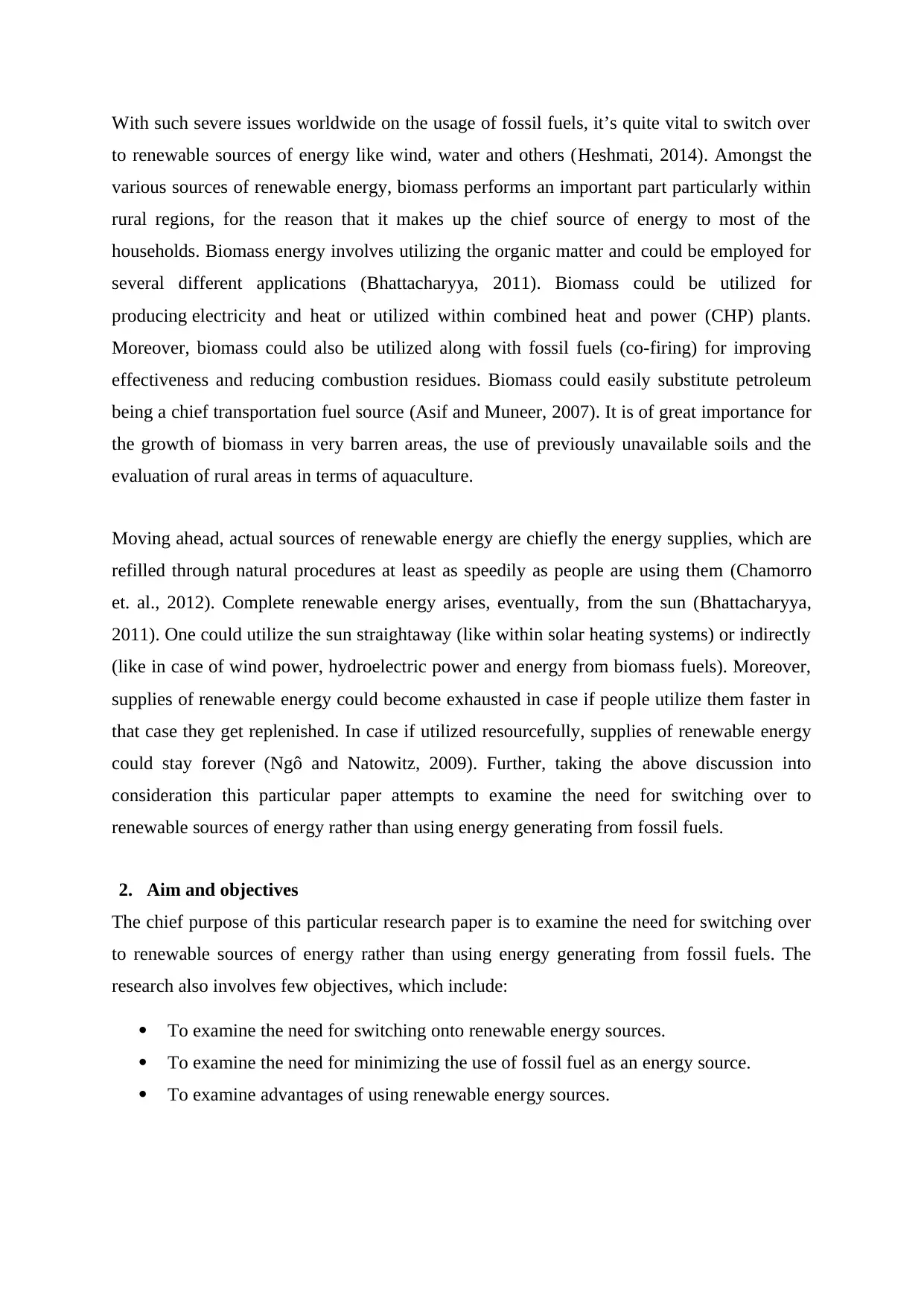
With such severe issues worldwide on the usage of fossil fuels, it’s quite vital to switch over
to renewable sources of energy like wind, water and others (Heshmati, 2014). Amongst the
various sources of renewable energy, biomass performs an important part particularly within
rural regions, for the reason that it makes up the chief source of energy to most of the
households. Biomass energy involves utilizing the organic matter and could be employed for
several different applications (Bhattacharyya, 2011). Biomass could be utilized for
producing electricity and heat or utilized within combined heat and power (CHP) plants.
Moreover, biomass could also be utilized along with fossil fuels (co-firing) for improving
effectiveness and reducing combustion residues. Biomass could easily substitute petroleum
being a chief transportation fuel source (Asif and Muneer, 2007). It is of great importance for
the growth of biomass in very barren areas, the use of previously unavailable soils and the
evaluation of rural areas in terms of aquaculture.
Moving ahead, actual sources of renewable energy are chiefly the energy supplies, which are
refilled through natural procedures at least as speedily as people are using them (Chamorro
et. al., 2012). Complete renewable energy arises, eventually, from the sun (Bhattacharyya,
2011). One could utilize the sun straightaway (like within solar heating systems) or indirectly
(like in case of wind power, hydroelectric power and energy from biomass fuels). Moreover,
supplies of renewable energy could become exhausted in case if people utilize them faster in
that case they get replenished. In case if utilized resourcefully, supplies of renewable energy
could stay forever (Ngô and Natowitz, 2009). Further, taking the above discussion into
consideration this particular paper attempts to examine the need for switching over to
renewable sources of energy rather than using energy generating from fossil fuels.
2. Aim and objectives
The chief purpose of this particular research paper is to examine the need for switching over
to renewable sources of energy rather than using energy generating from fossil fuels. The
research also involves few objectives, which include:
To examine the need for switching onto renewable energy sources.
To examine the need for minimizing the use of fossil fuel as an energy source.
To examine advantages of using renewable energy sources.
to renewable sources of energy like wind, water and others (Heshmati, 2014). Amongst the
various sources of renewable energy, biomass performs an important part particularly within
rural regions, for the reason that it makes up the chief source of energy to most of the
households. Biomass energy involves utilizing the organic matter and could be employed for
several different applications (Bhattacharyya, 2011). Biomass could be utilized for
producing electricity and heat or utilized within combined heat and power (CHP) plants.
Moreover, biomass could also be utilized along with fossil fuels (co-firing) for improving
effectiveness and reducing combustion residues. Biomass could easily substitute petroleum
being a chief transportation fuel source (Asif and Muneer, 2007). It is of great importance for
the growth of biomass in very barren areas, the use of previously unavailable soils and the
evaluation of rural areas in terms of aquaculture.
Moving ahead, actual sources of renewable energy are chiefly the energy supplies, which are
refilled through natural procedures at least as speedily as people are using them (Chamorro
et. al., 2012). Complete renewable energy arises, eventually, from the sun (Bhattacharyya,
2011). One could utilize the sun straightaway (like within solar heating systems) or indirectly
(like in case of wind power, hydroelectric power and energy from biomass fuels). Moreover,
supplies of renewable energy could become exhausted in case if people utilize them faster in
that case they get replenished. In case if utilized resourcefully, supplies of renewable energy
could stay forever (Ngô and Natowitz, 2009). Further, taking the above discussion into
consideration this particular paper attempts to examine the need for switching over to
renewable sources of energy rather than using energy generating from fossil fuels.
2. Aim and objectives
The chief purpose of this particular research paper is to examine the need for switching over
to renewable sources of energy rather than using energy generating from fossil fuels. The
research also involves few objectives, which include:
To examine the need for switching onto renewable energy sources.
To examine the need for minimizing the use of fossil fuel as an energy source.
To examine advantages of using renewable energy sources.
Secure Best Marks with AI Grader
Need help grading? Try our AI Grader for instant feedback on your assignments.
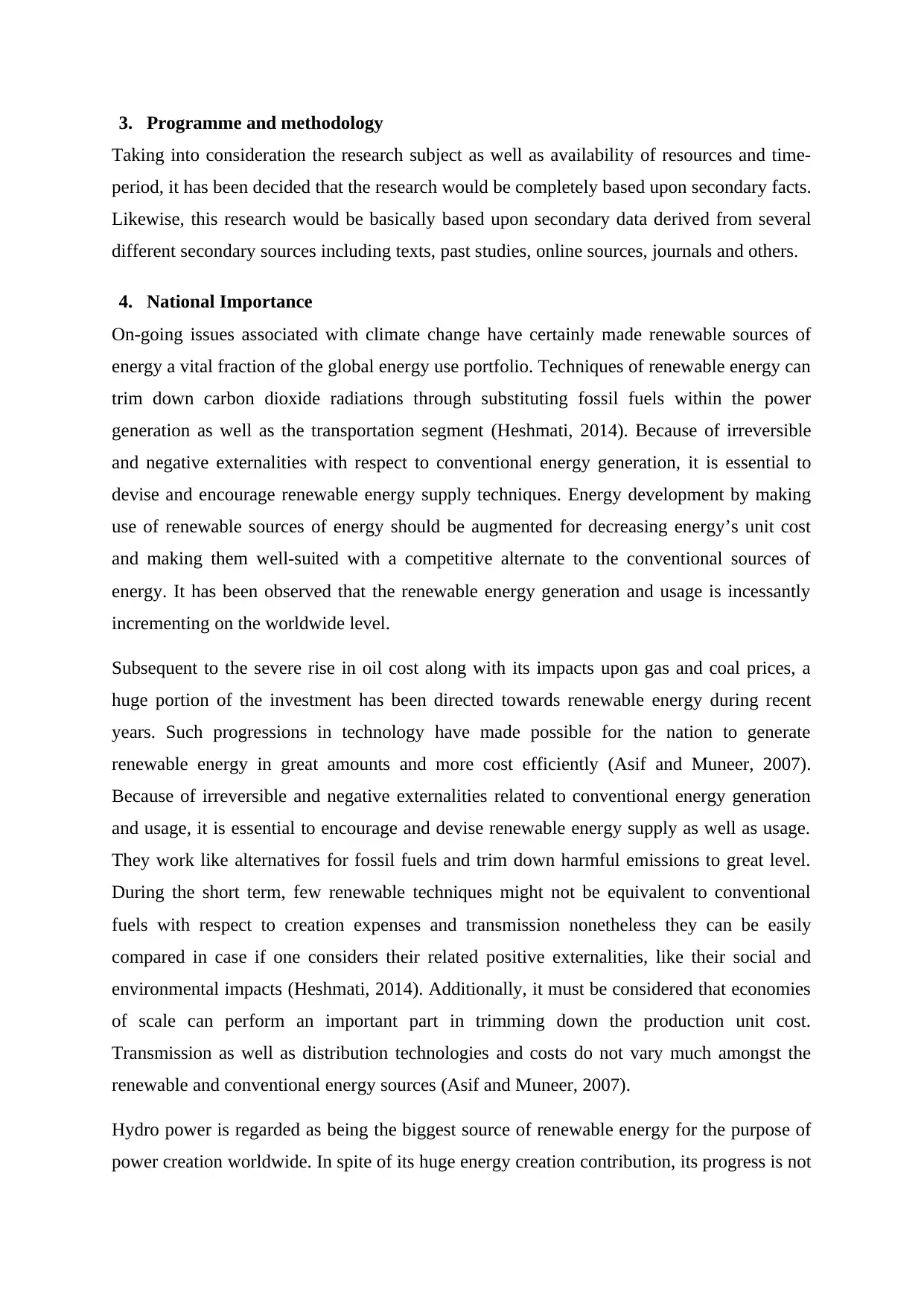
3. Programme and methodology
Taking into consideration the research subject as well as availability of resources and time-
period, it has been decided that the research would be completely based upon secondary facts.
Likewise, this research would be basically based upon secondary data derived from several
different secondary sources including texts, past studies, online sources, journals and others.
4. National Importance
On-going issues associated with climate change have certainly made renewable sources of
energy a vital fraction of the global energy use portfolio. Techniques of renewable energy can
trim down carbon dioxide radiations through substituting fossil fuels within the power
generation as well as the transportation segment (Heshmati, 2014). Because of irreversible
and negative externalities with respect to conventional energy generation, it is essential to
devise and encourage renewable energy supply techniques. Energy development by making
use of renewable sources of energy should be augmented for decreasing energy’s unit cost
and making them well-suited with a competitive alternate to the conventional sources of
energy. It has been observed that the renewable energy generation and usage is incessantly
incrementing on the worldwide level.
Subsequent to the severe rise in oil cost along with its impacts upon gas and coal prices, a
huge portion of the investment has been directed towards renewable energy during recent
years. Such progressions in technology have made possible for the nation to generate
renewable energy in great amounts and more cost efficiently (Asif and Muneer, 2007).
Because of irreversible and negative externalities related to conventional energy generation
and usage, it is essential to encourage and devise renewable energy supply as well as usage.
They work like alternatives for fossil fuels and trim down harmful emissions to great level.
During the short term, few renewable techniques might not be equivalent to conventional
fuels with respect to creation expenses and transmission nonetheless they can be easily
compared in case if one considers their related positive externalities, like their social and
environmental impacts (Heshmati, 2014). Additionally, it must be considered that economies
of scale can perform an important part in trimming down the production unit cost.
Transmission as well as distribution technologies and costs do not vary much amongst the
renewable and conventional energy sources (Asif and Muneer, 2007).
Hydro power is regarded as being the biggest source of renewable energy for the purpose of
power creation worldwide. In spite of its huge energy creation contribution, its progress is not
Taking into consideration the research subject as well as availability of resources and time-
period, it has been decided that the research would be completely based upon secondary facts.
Likewise, this research would be basically based upon secondary data derived from several
different secondary sources including texts, past studies, online sources, journals and others.
4. National Importance
On-going issues associated with climate change have certainly made renewable sources of
energy a vital fraction of the global energy use portfolio. Techniques of renewable energy can
trim down carbon dioxide radiations through substituting fossil fuels within the power
generation as well as the transportation segment (Heshmati, 2014). Because of irreversible
and negative externalities with respect to conventional energy generation, it is essential to
devise and encourage renewable energy supply techniques. Energy development by making
use of renewable sources of energy should be augmented for decreasing energy’s unit cost
and making them well-suited with a competitive alternate to the conventional sources of
energy. It has been observed that the renewable energy generation and usage is incessantly
incrementing on the worldwide level.
Subsequent to the severe rise in oil cost along with its impacts upon gas and coal prices, a
huge portion of the investment has been directed towards renewable energy during recent
years. Such progressions in technology have made possible for the nation to generate
renewable energy in great amounts and more cost efficiently (Asif and Muneer, 2007).
Because of irreversible and negative externalities related to conventional energy generation
and usage, it is essential to encourage and devise renewable energy supply as well as usage.
They work like alternatives for fossil fuels and trim down harmful emissions to great level.
During the short term, few renewable techniques might not be equivalent to conventional
fuels with respect to creation expenses and transmission nonetheless they can be easily
compared in case if one considers their related positive externalities, like their social and
environmental impacts (Heshmati, 2014). Additionally, it must be considered that economies
of scale can perform an important part in trimming down the production unit cost.
Transmission as well as distribution technologies and costs do not vary much amongst the
renewable and conventional energy sources (Asif and Muneer, 2007).
Hydro power is regarded as being the biggest source of renewable energy for the purpose of
power creation worldwide. In spite of its huge energy creation contribution, its progress is not
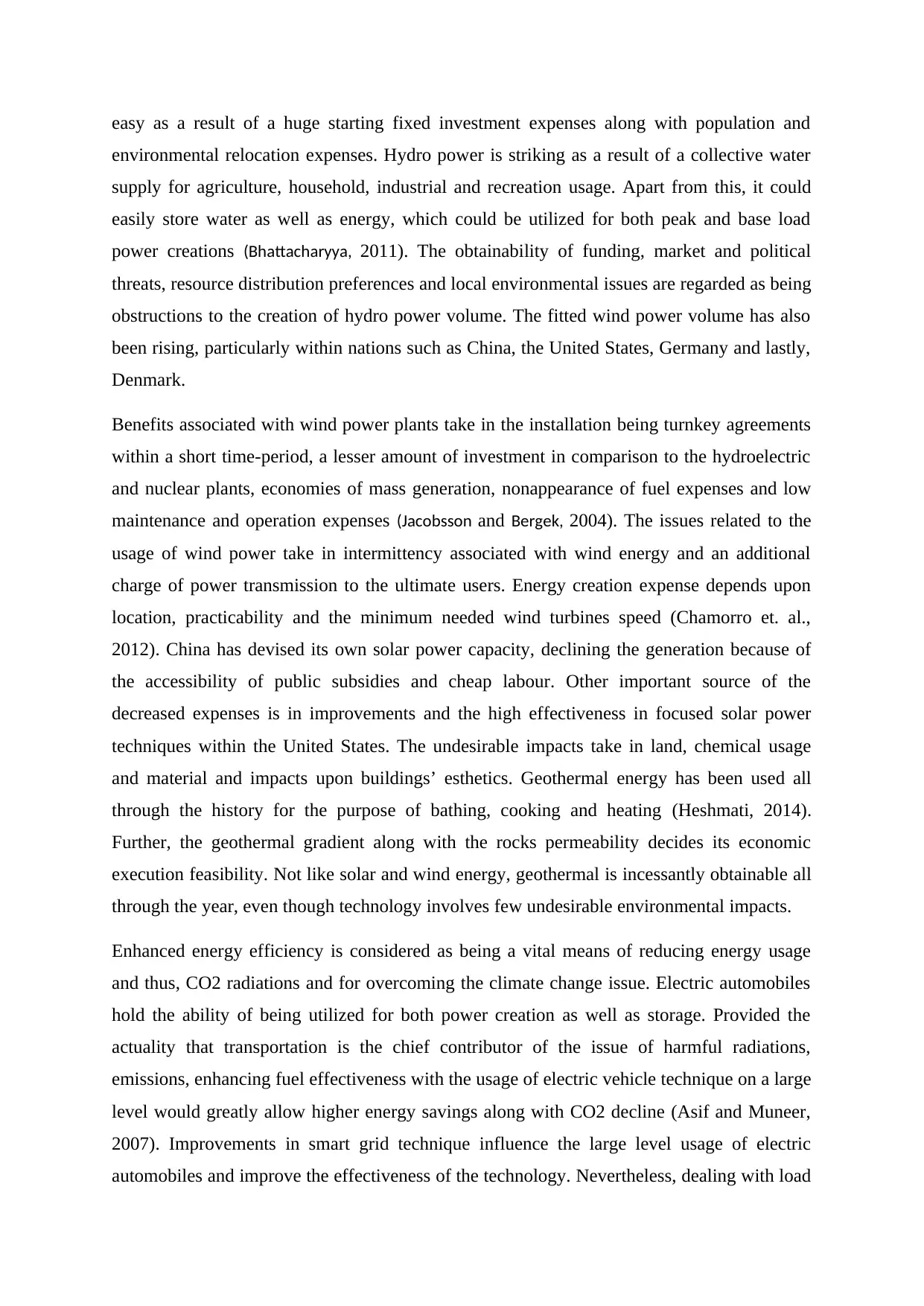
easy as a result of a huge starting fixed investment expenses along with population and
environmental relocation expenses. Hydro power is striking as a result of a collective water
supply for agriculture, household, industrial and recreation usage. Apart from this, it could
easily store water as well as energy, which could be utilized for both peak and base load
power creations (Bhattacharyya, 2011). The obtainability of funding, market and political
threats, resource distribution preferences and local environmental issues are regarded as being
obstructions to the creation of hydro power volume. The fitted wind power volume has also
been rising, particularly within nations such as China, the United States, Germany and lastly,
Denmark.
Benefits associated with wind power plants take in the installation being turnkey agreements
within a short time-period, a lesser amount of investment in comparison to the hydroelectric
and nuclear plants, economies of mass generation, nonappearance of fuel expenses and low
maintenance and operation expenses (Jacobsson and Bergek, 2004). The issues related to the
usage of wind power take in intermittency associated with wind energy and an additional
charge of power transmission to the ultimate users. Energy creation expense depends upon
location, practicability and the minimum needed wind turbines speed (Chamorro et. al.,
2012). China has devised its own solar power capacity, declining the generation because of
the accessibility of public subsidies and cheap labour. Other important source of the
decreased expenses is in improvements and the high effectiveness in focused solar power
techniques within the United States. The undesirable impacts take in land, chemical usage
and material and impacts upon buildings’ esthetics. Geothermal energy has been used all
through the history for the purpose of bathing, cooking and heating (Heshmati, 2014).
Further, the geothermal gradient along with the rocks permeability decides its economic
execution feasibility. Not like solar and wind energy, geothermal is incessantly obtainable all
through the year, even though technology involves few undesirable environmental impacts.
Enhanced energy efficiency is considered as being a vital means of reducing energy usage
and thus, CO2 radiations and for overcoming the climate change issue. Electric automobiles
hold the ability of being utilized for both power creation as well as storage. Provided the
actuality that transportation is the chief contributor of the issue of harmful radiations,
emissions, enhancing fuel effectiveness with the usage of electric vehicle technique on a large
level would greatly allow higher energy savings along with CO2 decline (Asif and Muneer,
2007). Improvements in smart grid technique influence the large level usage of electric
automobiles and improve the effectiveness of the technology. Nevertheless, dealing with load
environmental relocation expenses. Hydro power is striking as a result of a collective water
supply for agriculture, household, industrial and recreation usage. Apart from this, it could
easily store water as well as energy, which could be utilized for both peak and base load
power creations (Bhattacharyya, 2011). The obtainability of funding, market and political
threats, resource distribution preferences and local environmental issues are regarded as being
obstructions to the creation of hydro power volume. The fitted wind power volume has also
been rising, particularly within nations such as China, the United States, Germany and lastly,
Denmark.
Benefits associated with wind power plants take in the installation being turnkey agreements
within a short time-period, a lesser amount of investment in comparison to the hydroelectric
and nuclear plants, economies of mass generation, nonappearance of fuel expenses and low
maintenance and operation expenses (Jacobsson and Bergek, 2004). The issues related to the
usage of wind power take in intermittency associated with wind energy and an additional
charge of power transmission to the ultimate users. Energy creation expense depends upon
location, practicability and the minimum needed wind turbines speed (Chamorro et. al.,
2012). China has devised its own solar power capacity, declining the generation because of
the accessibility of public subsidies and cheap labour. Other important source of the
decreased expenses is in improvements and the high effectiveness in focused solar power
techniques within the United States. The undesirable impacts take in land, chemical usage
and material and impacts upon buildings’ esthetics. Geothermal energy has been used all
through the history for the purpose of bathing, cooking and heating (Heshmati, 2014).
Further, the geothermal gradient along with the rocks permeability decides its economic
execution feasibility. Not like solar and wind energy, geothermal is incessantly obtainable all
through the year, even though technology involves few undesirable environmental impacts.
Enhanced energy efficiency is considered as being a vital means of reducing energy usage
and thus, CO2 radiations and for overcoming the climate change issue. Electric automobiles
hold the ability of being utilized for both power creation as well as storage. Provided the
actuality that transportation is the chief contributor of the issue of harmful radiations,
emissions, enhancing fuel effectiveness with the usage of electric vehicle technique on a large
level would greatly allow higher energy savings along with CO2 decline (Asif and Muneer,
2007). Improvements in smart grid technique influence the large level usage of electric
automobiles and improve the effectiveness of the technology. Nevertheless, dealing with load
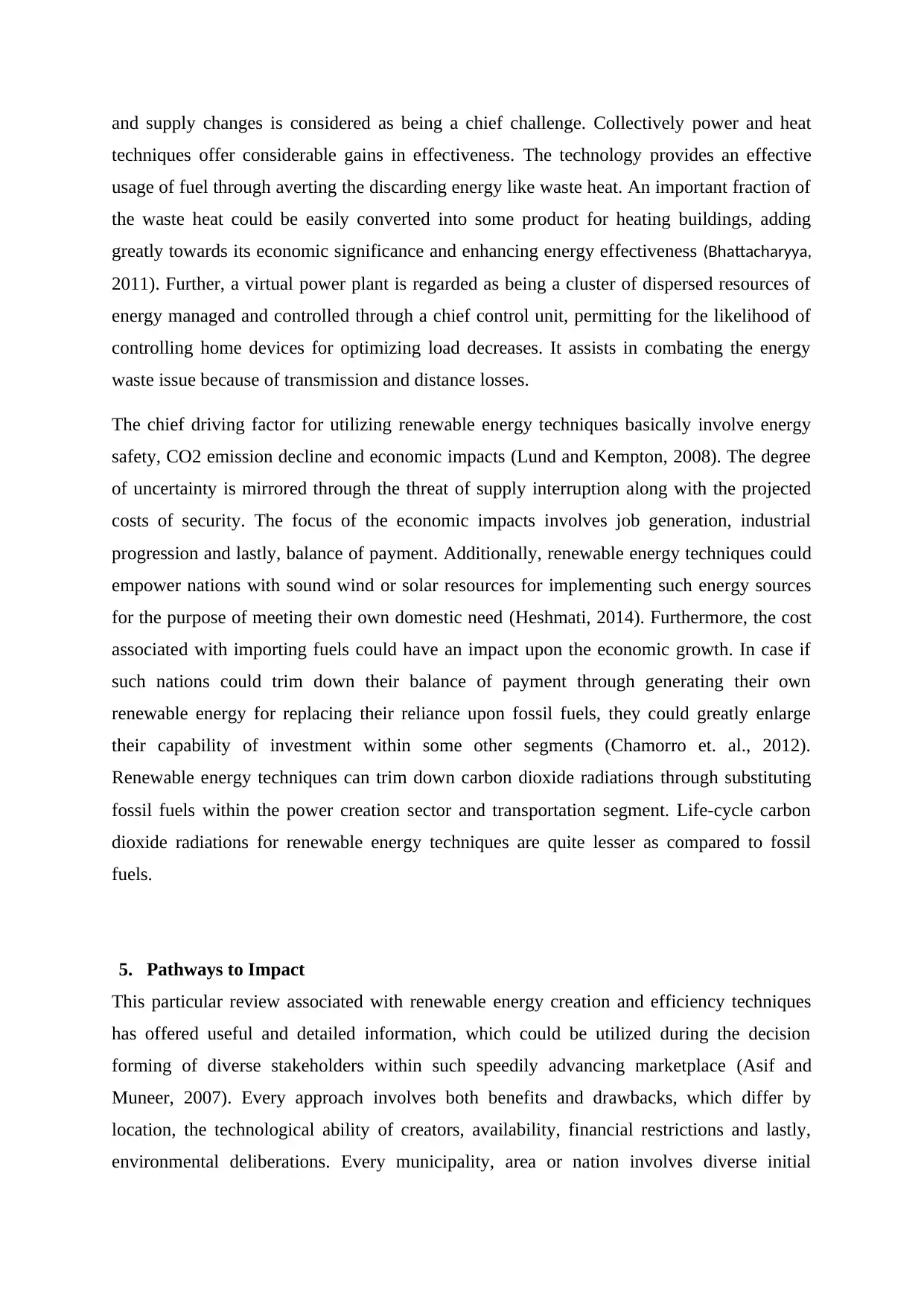
and supply changes is considered as being a chief challenge. Collectively power and heat
techniques offer considerable gains in effectiveness. The technology provides an effective
usage of fuel through averting the discarding energy like waste heat. An important fraction of
the waste heat could be easily converted into some product for heating buildings, adding
greatly towards its economic significance and enhancing energy effectiveness (Bhattacharyya,
2011). Further, a virtual power plant is regarded as being a cluster of dispersed resources of
energy managed and controlled through a chief control unit, permitting for the likelihood of
controlling home devices for optimizing load decreases. It assists in combating the energy
waste issue because of transmission and distance losses.
The chief driving factor for utilizing renewable energy techniques basically involve energy
safety, CO2 emission decline and economic impacts (Lund and Kempton, 2008). The degree
of uncertainty is mirrored through the threat of supply interruption along with the projected
costs of security. The focus of the economic impacts involves job generation, industrial
progression and lastly, balance of payment. Additionally, renewable energy techniques could
empower nations with sound wind or solar resources for implementing such energy sources
for the purpose of meeting their own domestic need (Heshmati, 2014). Furthermore, the cost
associated with importing fuels could have an impact upon the economic growth. In case if
such nations could trim down their balance of payment through generating their own
renewable energy for replacing their reliance upon fossil fuels, they could greatly enlarge
their capability of investment within some other segments (Chamorro et. al., 2012).
Renewable energy techniques can trim down carbon dioxide radiations through substituting
fossil fuels within the power creation sector and transportation segment. Life-cycle carbon
dioxide radiations for renewable energy techniques are quite lesser as compared to fossil
fuels.
5. Pathways to Impact
This particular review associated with renewable energy creation and efficiency techniques
has offered useful and detailed information, which could be utilized during the decision
forming of diverse stakeholders within such speedily advancing marketplace (Asif and
Muneer, 2007). Every approach involves both benefits and drawbacks, which differ by
location, the technological ability of creators, availability, financial restrictions and lastly,
environmental deliberations. Every municipality, area or nation involves diverse initial
techniques offer considerable gains in effectiveness. The technology provides an effective
usage of fuel through averting the discarding energy like waste heat. An important fraction of
the waste heat could be easily converted into some product for heating buildings, adding
greatly towards its economic significance and enhancing energy effectiveness (Bhattacharyya,
2011). Further, a virtual power plant is regarded as being a cluster of dispersed resources of
energy managed and controlled through a chief control unit, permitting for the likelihood of
controlling home devices for optimizing load decreases. It assists in combating the energy
waste issue because of transmission and distance losses.
The chief driving factor for utilizing renewable energy techniques basically involve energy
safety, CO2 emission decline and economic impacts (Lund and Kempton, 2008). The degree
of uncertainty is mirrored through the threat of supply interruption along with the projected
costs of security. The focus of the economic impacts involves job generation, industrial
progression and lastly, balance of payment. Additionally, renewable energy techniques could
empower nations with sound wind or solar resources for implementing such energy sources
for the purpose of meeting their own domestic need (Heshmati, 2014). Furthermore, the cost
associated with importing fuels could have an impact upon the economic growth. In case if
such nations could trim down their balance of payment through generating their own
renewable energy for replacing their reliance upon fossil fuels, they could greatly enlarge
their capability of investment within some other segments (Chamorro et. al., 2012).
Renewable energy techniques can trim down carbon dioxide radiations through substituting
fossil fuels within the power creation sector and transportation segment. Life-cycle carbon
dioxide radiations for renewable energy techniques are quite lesser as compared to fossil
fuels.
5. Pathways to Impact
This particular review associated with renewable energy creation and efficiency techniques
has offered useful and detailed information, which could be utilized during the decision
forming of diverse stakeholders within such speedily advancing marketplace (Asif and
Muneer, 2007). Every approach involves both benefits and drawbacks, which differ by
location, the technological ability of creators, availability, financial restrictions and lastly,
environmental deliberations. Every municipality, area or nation involves diverse initial
Paraphrase This Document
Need a fresh take? Get an instant paraphrase of this document with our AI Paraphraser
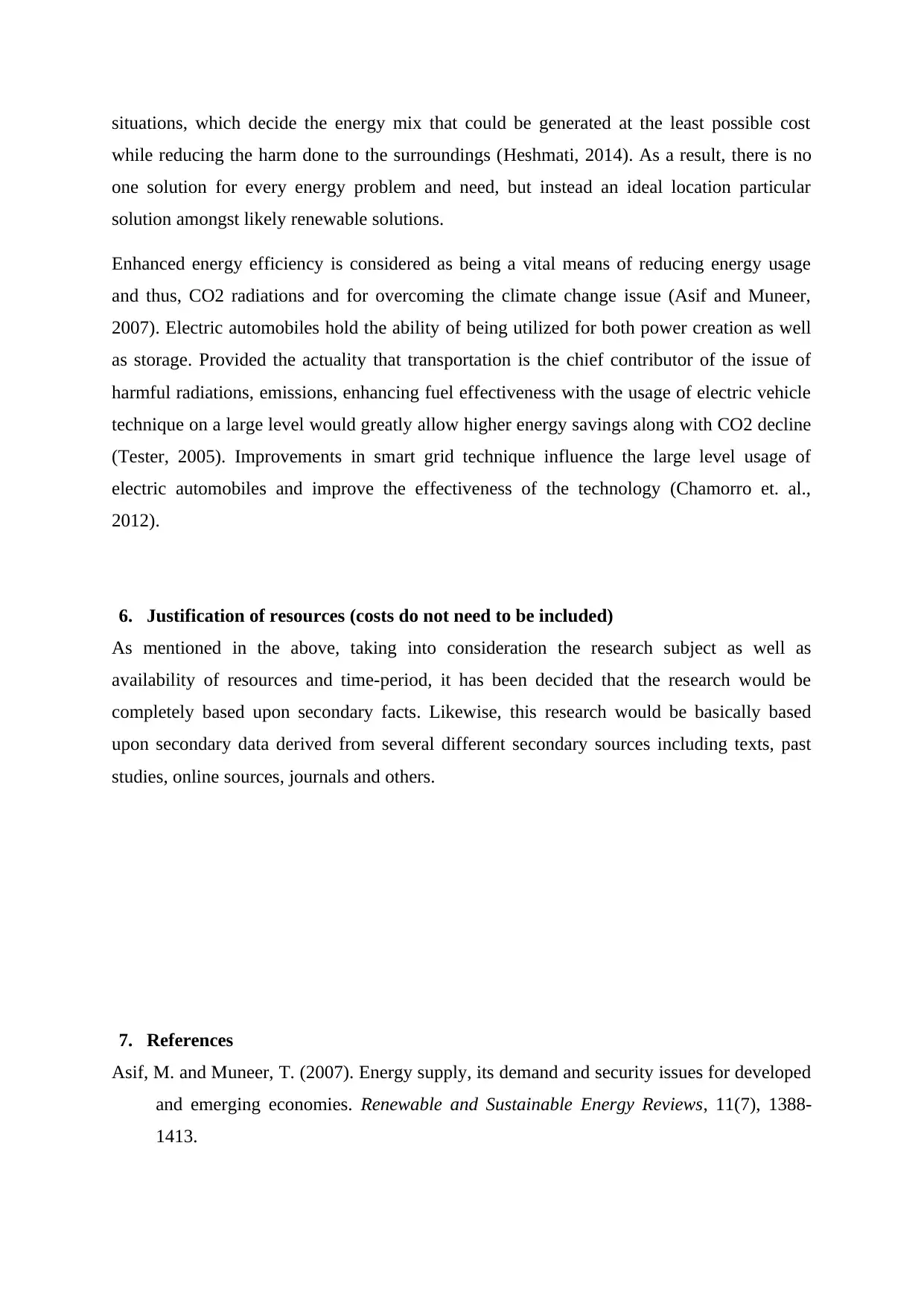
situations, which decide the energy mix that could be generated at the least possible cost
while reducing the harm done to the surroundings (Heshmati, 2014). As a result, there is no
one solution for every energy problem and need, but instead an ideal location particular
solution amongst likely renewable solutions.
Enhanced energy efficiency is considered as being a vital means of reducing energy usage
and thus, CO2 radiations and for overcoming the climate change issue (Asif and Muneer,
2007). Electric automobiles hold the ability of being utilized for both power creation as well
as storage. Provided the actuality that transportation is the chief contributor of the issue of
harmful radiations, emissions, enhancing fuel effectiveness with the usage of electric vehicle
technique on a large level would greatly allow higher energy savings along with CO2 decline
(Tester, 2005). Improvements in smart grid technique influence the large level usage of
electric automobiles and improve the effectiveness of the technology (Chamorro et. al.,
2012).
6. Justification of resources (costs do not need to be included)
As mentioned in the above, taking into consideration the research subject as well as
availability of resources and time-period, it has been decided that the research would be
completely based upon secondary facts. Likewise, this research would be basically based
upon secondary data derived from several different secondary sources including texts, past
studies, online sources, journals and others.
7. References
Asif, M. and Muneer, T. (2007). Energy supply, its demand and security issues for developed
and emerging economies. Renewable and Sustainable Energy Reviews, 11(7), 1388-
1413.
while reducing the harm done to the surroundings (Heshmati, 2014). As a result, there is no
one solution for every energy problem and need, but instead an ideal location particular
solution amongst likely renewable solutions.
Enhanced energy efficiency is considered as being a vital means of reducing energy usage
and thus, CO2 radiations and for overcoming the climate change issue (Asif and Muneer,
2007). Electric automobiles hold the ability of being utilized for both power creation as well
as storage. Provided the actuality that transportation is the chief contributor of the issue of
harmful radiations, emissions, enhancing fuel effectiveness with the usage of electric vehicle
technique on a large level would greatly allow higher energy savings along with CO2 decline
(Tester, 2005). Improvements in smart grid technique influence the large level usage of
electric automobiles and improve the effectiveness of the technology (Chamorro et. al.,
2012).
6. Justification of resources (costs do not need to be included)
As mentioned in the above, taking into consideration the research subject as well as
availability of resources and time-period, it has been decided that the research would be
completely based upon secondary facts. Likewise, this research would be basically based
upon secondary data derived from several different secondary sources including texts, past
studies, online sources, journals and others.
7. References
Asif, M. and Muneer, T. (2007). Energy supply, its demand and security issues for developed
and emerging economies. Renewable and Sustainable Energy Reviews, 11(7), 1388-
1413.
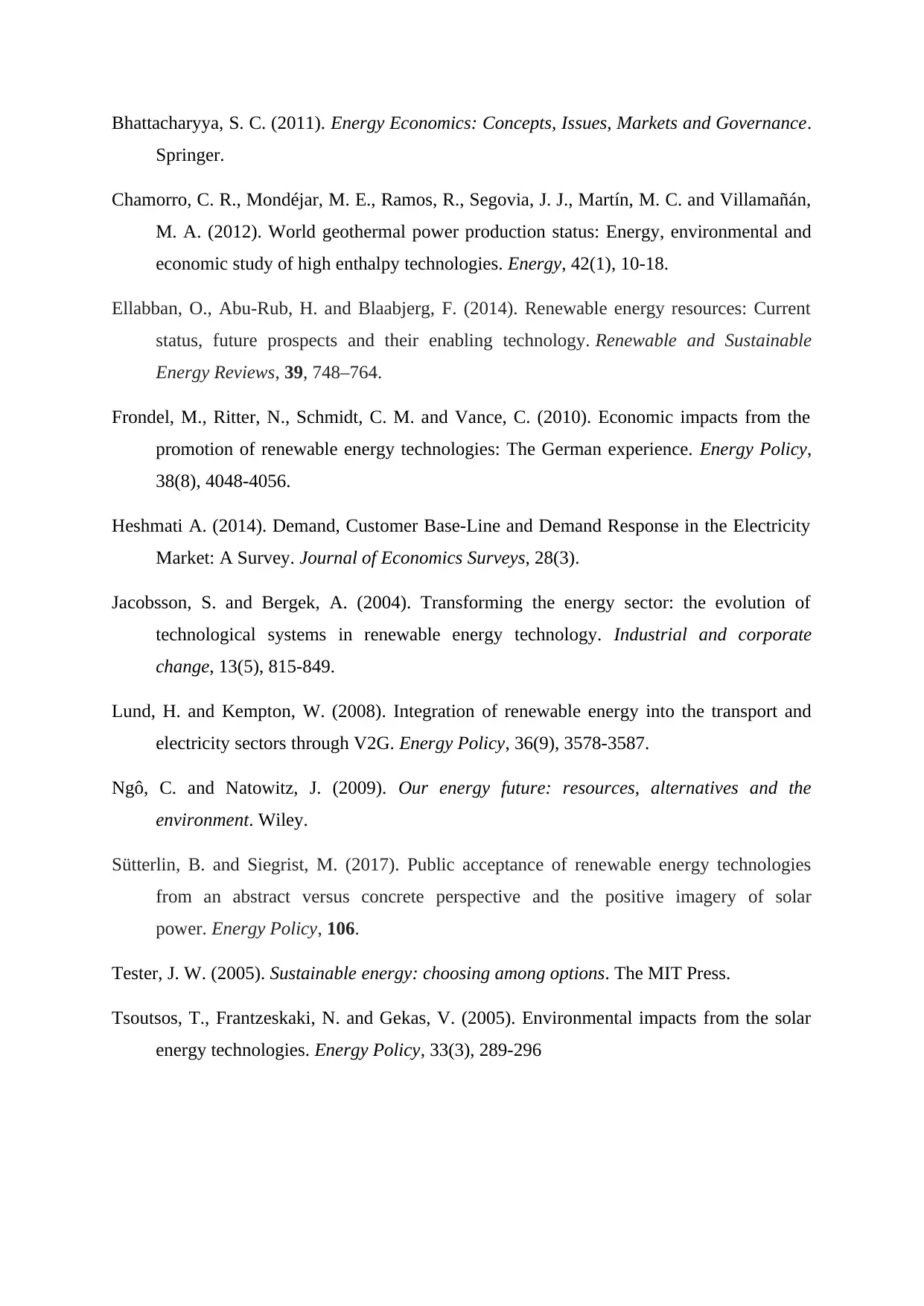
Bhattacharyya, S. C. (2011). Energy Economics: Concepts, Issues, Markets and Governance.
Springer.
Chamorro, C. R., Mondéjar, M. E., Ramos, R., Segovia, J. J., Martín, M. C. and Villamañán,
M. A. (2012). World geothermal power production status: Energy, environmental and
economic study of high enthalpy technologies. Energy, 42(1), 10-18.
Ellabban, O., Abu-Rub, H. and Blaabjerg, F. (2014). Renewable energy resources: Current
status, future prospects and their enabling technology. Renewable and Sustainable
Energy Reviews, 39, 748–764.
Frondel, M., Ritter, N., Schmidt, C. M. and Vance, C. (2010). Economic impacts from the
promotion of renewable energy technologies: The German experience. Energy Policy,
38(8), 4048-4056.
Heshmati A. (2014). Demand, Customer Base-Line and Demand Response in the Electricity
Market: A Survey. Journal of Economics Surveys, 28(3).
Jacobsson, S. and Bergek, A. (2004). Transforming the energy sector: the evolution of
technological systems in renewable energy technology. Industrial and corporate
change, 13(5), 815-849.
Lund, H. and Kempton, W. (2008). Integration of renewable energy into the transport and
electricity sectors through V2G. Energy Policy, 36(9), 3578-3587.
Ngô, C. and Natowitz, J. (2009). Our energy future: resources, alternatives and the
environment. Wiley.
Sütterlin, B. and Siegrist, M. (2017). Public acceptance of renewable energy technologies
from an abstract versus concrete perspective and the positive imagery of solar
power. Energy Policy, 106.
Tester, J. W. (2005). Sustainable energy: choosing among options. The MIT Press.
Tsoutsos, T., Frantzeskaki, N. and Gekas, V. (2005). Environmental impacts from the solar
energy technologies. Energy Policy, 33(3), 289-296
Springer.
Chamorro, C. R., Mondéjar, M. E., Ramos, R., Segovia, J. J., Martín, M. C. and Villamañán,
M. A. (2012). World geothermal power production status: Energy, environmental and
economic study of high enthalpy technologies. Energy, 42(1), 10-18.
Ellabban, O., Abu-Rub, H. and Blaabjerg, F. (2014). Renewable energy resources: Current
status, future prospects and their enabling technology. Renewable and Sustainable
Energy Reviews, 39, 748–764.
Frondel, M., Ritter, N., Schmidt, C. M. and Vance, C. (2010). Economic impacts from the
promotion of renewable energy technologies: The German experience. Energy Policy,
38(8), 4048-4056.
Heshmati A. (2014). Demand, Customer Base-Line and Demand Response in the Electricity
Market: A Survey. Journal of Economics Surveys, 28(3).
Jacobsson, S. and Bergek, A. (2004). Transforming the energy sector: the evolution of
technological systems in renewable energy technology. Industrial and corporate
change, 13(5), 815-849.
Lund, H. and Kempton, W. (2008). Integration of renewable energy into the transport and
electricity sectors through V2G. Energy Policy, 36(9), 3578-3587.
Ngô, C. and Natowitz, J. (2009). Our energy future: resources, alternatives and the
environment. Wiley.
Sütterlin, B. and Siegrist, M. (2017). Public acceptance of renewable energy technologies
from an abstract versus concrete perspective and the positive imagery of solar
power. Energy Policy, 106.
Tester, J. W. (2005). Sustainable energy: choosing among options. The MIT Press.
Tsoutsos, T., Frantzeskaki, N. and Gekas, V. (2005). Environmental impacts from the solar
energy technologies. Energy Policy, 33(3), 289-296
1 out of 9
Related Documents
Your All-in-One AI-Powered Toolkit for Academic Success.
+13062052269
info@desklib.com
Available 24*7 on WhatsApp / Email
![[object Object]](/_next/static/media/star-bottom.7253800d.svg)
Unlock your academic potential
© 2024 | Zucol Services PVT LTD | All rights reserved.




